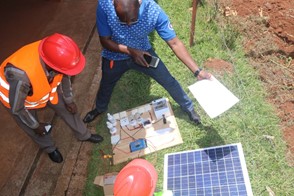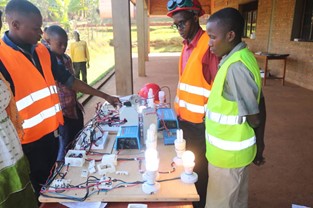Shortly after class II ended, another began on August 3rd with new participants. It was expected to be particular as it was mostly comprised of public school teachers. It was made to be intensive so as to equip them with comparable skill and knowledge levels as that of field technicians with installation capabilities, all that to be done before school year started.
As previously done, Mr. Adelin began with selection exam followed by a meet-and-greet session. Each participant got to share their background, academic level, technical experience, and personal expectations for this training program. As usual, teaching staff utilize this information to tailor the course beneficiaries’ needs and requirements. Therefore, it was understood that this class would require more hands-on activities in order to shorten the lead taken by those with more field experience.
On Wednesday August 4th, students were given a general introduction to the world of renewable energies. The talk was followed by a preliminary discourse on photovoltaic energy systems. The lecturer addressed the different reasons why PV systems ware most suited to the Burundi and East African context. Also, the learners were shown the main PV systems components and their attributes.
The following day, August 5th, Mr. Adelin taught on inverters, explaining the types and the characteristics used in order to set them apart. Then he went on to lecture about photovoltaic cells in order to deepen students’ understanding the physics behind each energy system. This is especially important during systems design, diagnostic and/or maintenance.
On day 4, participants studied PV cell combinations and did their first workshop. During group exercises, they were tasked to identify the main system components, and explain the meaning of the technical descriptions written on the equipments. Beyond seeing pictures of them, physically handling them at the AKARARO center gave the students a broader understanding of these elements.
Second week of classes began with a review of PV systems components. As the previous session was a first for some attendants seeing and handling items such inverters, charge controllers, or junction boxes, the instructor took time to go through each of the parts in more details so as to help ground the participants’ comprehension. Thus each individual was given an opportunity to explore and ask questions, doing so in an open workshop format.
On Wednesday, students were taught about the Multimeter. For electricians, this may be the most important tool to know about. If operated correctly, it makes an unequalled difference during installation and maintenance through its data collection capabilities. Through an exercise format, the teacher was able to communicate some of the most important features of this device and how helpful it can be as related to each main PV system component.
The next day, Mr. Adelin lectured on electrical diagrams for lighting installations for the most common categories: simple lighting, two-way lighting, and double two-way lighting. In addition to the drawings explained, a functional demo unit was assembled for the students to have a deeper understanding of these different scenarios.
On Friday the 14th, the curriculum continued onto the different types of cables and systems protection. Attendants learned about the need and advantages of proper protection throughout the system from energy production to its consumption. Later, a site visit was also organized by ITCO teaching staff in order for participants to see more examples of operational PV energy systems and get additional field experience.
Day 9 was held on Tuesday August 18th. The blitz day was mainly to provide practical training on electrical multi-wire diagrams. Installations simulations were made to mimic what the students would encounter on the field as maintainers and/or installers. This lesson remains one of the most important hands-on sessions as it attempts to cut the core of what many installers do wrong for lack of knowledge in order to minimize avoidable incidents.
The next two days, the instructor taught on electrification, electrocution, and what to do in case of an electricity-related accident. Though a technician’s discipline is in their careful assessment and execution of installations, the rare occurrences of accidents need to be addressed swiftly and correctly. Thus participants were taught the best way to react in order to avoid extensive damages and even death in the most extreme circumstances.
On Friday August 21st and the following Tuesday, hands-on sessions continued with the subject matter of proper install of lights and wall sockets. As mentioned before, some classmates had little to no previous technical experience. Since many tend to agree that practice makes perfect, the teaching staff concluded that these elementary school teachers would certainly benefit from more practical exercises.
On day 14, the teaching electrical engineer proceeded with an in-depth review and demonstration of how to install a two-way lighting. The complexity of the wiring involved required the instructor to slowly explain and demonstrate the process multiple times. Afterwards, it was up to those being educated to build their own models in teams of two.
The next morning, Mr. Berry lectured on the basics of entrepreneurship. It was important to challenge each scholar to develop business-minded qualities such as creativity, willingness to learn and work hard, striving for structure while committing to continuous self-improvement. This quick change of pace and subject provided somewhat of a break from the heavy technical training by shifting onto the business side of project management duties which each installer/technician has to consider to be successful.
On Friday the 28th, it was back to dealing with double two-way lighting for the students as they continued to build their own functioning mini-systems. In the subsequently session, they got to add an inverter into the mix so as to go from DC to AC lighting and add a socket for charging cell-phones.
On the 1st September, a final evaluation was held in the form of a written exam. Fortunately, all participants received passing grades. On the 2nd, another trainer came back for an additional lecture on entrepreneurship. He gave pointers on how to select and access likely successful business ideas and projects. Afterwards, he lectured on business concepts such as market research, competition, niche, and others to be considered to improve as a technician. Furthermore, he addressed need to know the rules and regulation of the country and county to ensure ongoing achievements in any field of work. Finally, he provided pointers for where to find more information on registering a business entity.
In dealing with teachers as students, it was expected that the absorption capacity would be higher than that of previous classes. However, knowing in theory and taking a screwdriver to get down to handy workmanship are dissimilar endeavors. It was all the more important for these cautiously picked participants to receive proper and transferable capabilities seeing as they hold positions where they can greatly impact the youth.
The commencement ceremony was held on Friday September 3rd where certificates of course completion were handed out to each graduate, and a celebration followed after as with previous classes. What an amazing opportunity to teach teachers who are interested in acquiring technical skills and are already committed toward helping the next generation. It is the expectation of all involved in this project that more than any previous participants, these later participants would impact the community all the more.













